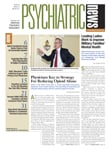Patients with schizophrenia having the most severe negative symptoms appear to endorse certain defeatist and asocial beliefs, as well as have low expectations of success or pleasure, characteristics that may be amenable to a form of cognitive-behavioral therapy.
That's important because the severe negative symptoms of "deficit-syndrome" patients have been presumed by some to be the result of neurobiological deficits that often do not respond either to antipsychotic medication or to standard psychosocial treatments. The "deficit syndrome" is thought to characterize a pathophysiologically distinct subgroup of patients with schizophrenia whose negative symptoms—blunted affect, anhedonia, avolition, and asociality—are enduring features that do not appear to be secondary to other aspects of schizophrenia.
But in an address titled "Defeatist Beliefs, Asocial Beliefs, and Low Expectations: The Emerging Cognitive Behavioral Science of Negative Symptoms and the Deficit Syndrome" at the International Congress of Schizophrenia Research (ICOSR), Paul Grant, Ph.D., described preliminary research showing that these chronic patients appear to endorse negative beliefs that may respond to goal-directed cognitive therapy.
That intervention is a form of therapy developed especially for schizophrenia patients by Aaron Beck, M.D., the renowned founder of cognitive therapy.
In comments to Psychiatric News following the presentation, Grant explained that the theory behind goal-directed cognitive therapy is that there may be "some psychological factors associated with the negative symptoms of these deficit-syndrome patients that are rarely targeted for treatment with antipsychotic medications and existing psychosocial treatments."
Grant said these deficit-syndrome patients are liable to comprise a large percentage—a quarter or a third—of the typical clinical population of patients with chronic schizophrenia.
"Our hypothesis was that some of these patients may have untapped potential and that there might be a level of negative attitudes and beliefs that were contributing to their low functioning," he told Psychiatric News.
To test the hypothesis, Grant and colleagues at the University of Pennsylvania used the Proxy for the Deficit Syndrome—a measurement tool described by Brian Kirkpatrick, M.D., and colleagues at the Maryland Psychiatric Research Center in the early 1990s—to identify 22 deficit-syndrome patients and 72 nondeficit schizophrenia patients. (The instrument uses the Brief Psychiatric Rating Scale to identify patients who have blunted affect but who do not have depressed mood, anxiety, hostility, or guilt feelings.)
Grant then compared the two groups for how frequently subjects endorsed a series of negative statements about the meaning of engaging in constructive activity and socializing, and their chances for future enjoyment. "We found that the deficit-syndrome patients actually endorse these attitudes more than the nondeficit patients who have negative symptoms," he reported.
For instance, deficit-syndrome patients were significantly more likely than non-deficit-syndrome patients to agree with statements such as: "If I fail partly, it is as bad as being a complete failure."
Similarly, the deficit-syndrome patients were significantly more likely to agree with statements about their willingness to engage socially with other patients, such as: "People sometimes think I am shy, when I really just want to be left alone."
Grant said both statements may represent reactions to past failures and social rejections. "If you come to believe these statements, you are not going to want to try to take even relatively minor risks," he said. "You might perceive that even a small risk could turn out to be a disaster."
A similar comparison was undertaken to test the groups' likelihood of endorsing a statement reflecting low expectation of pleasure from physical sensations, social activities, and recreational pursuits. Grant explained that the hypothesis behind this comparison is that the feature of anhedonia in deficit-syndrome patients may reflect not so much the inability to experience pleasure, but the fact that they do not expect to, and for that reason do not undertake pleasurable activities.
In this comparison, the deficit-syndrome group again scored higher than the control group—reflecting low expectations of pleasure—though the difference was not statistically significant.
Grant told Psychiatric News that some preliminary clinical research using goal-directed cognitive therapy has shown its efficacy in treating negative symptoms.
"The therapy is on a continuum with everything that Beck has done with developing cognitive-behavioral therapies," Grant said. "The critical idea is that even these deficit-syndrome patients may very well have goals if you can get them to articulate them."
Common goals that are articulated—to get a job, finish school, or have a girlfriend or a house or a car—are broken down into small, stepped tasks. Grant described one patient who expressed the belief that she couldn't read—in fact she could—and the therapy began by having her read a short paragraph out loud and longer texts later.
"In the framework of goal-directed therapy, you are not talking to patients about psychosis but about their functioning and their quality of life and working with them at a level they might be interested," he told Psychiatric News. "You treat the negative and positive symptoms as barriers to the goals."
He added that much of the emphasis of treatment research in schizophrenia has turned to adolescents and the prodrome—reflected in the number of sessions on these topics at the ICOSR—but goal-directed cognitive therapy targets a population of severely and chronically ill patients who have in some ways been left behind. "We think the things that are holding these patients back are these negative beliefs, so we look to identify them and help patients take actions to achieve what goals they can."
